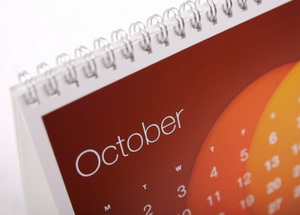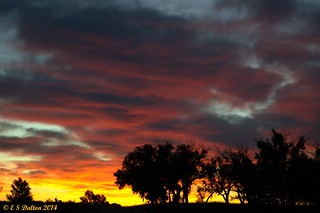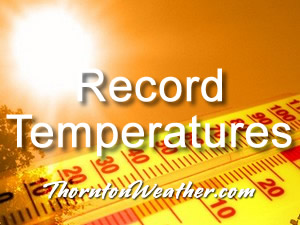
A very eventful week in Denver weather history with a wide variety of events from snow to summer-like severe weather. Most notable is five years ago today when multiple tornadoes touched down in the Brighton area. Read more about all the events below and scroll to a bottom for videos of the 2004 tornadoes.
From the National Weather Service:
From the 3rd to the 4th:
In 1969…the first snowfall of the season totaled 16.0 inches at Stapleton International Airport. There was a thunder snow shower on the evening of the 3rd…but otherwise little wind with the storm. The greatest snow depth on the ground was 8 inches due to melting. Heavy wet snow accumulated on trees…which were still in full leaf…and caused widespread damage from broken limbs and downed utility lines.
From the 3rd to the 5th:
In 1984…the remnants of pacific hurricane polo produced heavy rain over northeastern Colorado. Most locations received between 1.00 to 2.50 inches of rain…but 3.45 inches fell in Littleton. Rainfall totaled 1.73 inches at Stapleton International Airport…where north winds gusted to 24 mph.
On the 4th:
In 1912…sustained south winds to 55 mph with gusts to 60 mph raised the temperature to a high of 83 degrees… The warmest temperature of the month that year.
In 1924…west winds were sustained to 46 mph with gusts to 50 mph in the city. The apparent Bora winds cooled the temperature to a high of 57 degrees from a high of 70 degrees on the 3rd.
In 2004…several small tornadoes touched down near Brighton… Barr lake…and Hudson in Adams and southern weld counties. Most of these caused no damage. However…a small tornado 5 miles southeast of Brighton caused extensive damage to a recreational vehicle and severely damaged a barn. The barn was torn from its foundation…and the roof was thrown 100 feet. Four llamas in the barn were injured when it collapsed.
From the 4th to the 5th:
In 1997…unusually warm weather resulted in two temperature records. High temperature of 87 degrees on the 4th exceeded the old record set in 1922 by one degree. High temperature of 86 degrees on the 5th equaled the record set in 1990 and previous years.
On the 5th:
In 1962…unusually severe thunderstorms for this late in the season affected areas from Boulder northward. Hail up to golf ball size and strong gusty winds did much damage to roofs…windows…and signs in Boulder. Heavy rainfall caused local flooding.
In 1994…lightning caused a power outage to over 2400 homes for a few hours in and around Nederland in the foothills southwest of Boulder. Very strong winds accompanied the thunderstorm. Thunderstorm winds gusted to 60 mph and hail to 1/2 inch diameter fell in Lafayette. Strong microburst winds gusting to 69 mph near Strasburg caused an oil rig to topple onto two vehicles…injuring one person. The strong winds in the area also downed a few power poles… But caused power outages to only a few homes.
In 1995…strong winds spread from the foothills onto the plains. Wind gusts to 77 mph were reported atop squaw mountain west of Denver. On the plains…winds gusted to 60 mph at Kennesburg and to 62 mph near Strasburg. North winds gusted to 41 mph at Denver International Airport.
On the 6th:
In 1900…northwest winds were sustained to 40 mph with gusts as high as 50 mph in downtown Denver.
In 1903…northwest winds were sustained to 40 mph with gusts to 50 mph. The strong winds warmed the temperature to a high of 71 degrees in the city. The low reading was only 46 degrees.
In 1910…light smoke from forest fires drifted over the city.
In 1976…an arctic cold front brought light snow over the foothills above 6 thousand feet. Traffic was snarled at many locations. Only a trace of snow fell at Stapleton International Airport where rainfall totaled 0.20 inch and northeast winds gusted to 41 mph.
In 1991…the brilliant orange sunset was apparently the result of an extensive volcanic smoke layer in the upper atmosphere.
In 1994…strong west to northwest winds developed in the foothills above 9500 feet. A wind gust to 78 mph was recorded atop squaw mountain west of Denver and to 72 mph at ward northwest of Boulder. Northwest winds gusted to 35 mph at Stapleton International Airport.
In 2011…strong winds developed in and around the Denver area ahead of an approaching storm system. At the National Wind Technology Center…peak wind gusts ranged from 79 to 92 mph during the early morning hours. Across metro Denver…the strong winds toppled a few trees and damaged patio furniture. The wind caused a few flight delays at Denver International Airport due to a partial ground stoppage of incoming flights. Peak wind reports also included: 66 mph at Cedar Point…63 mph at Denver International Airport…60 mph at Buckley Air Force Base; 59 mph at Highlands Ranch; 58 mph at Deer Trail and Rocky Mountain Metro Airport in Broomfield; 55 mph at Bennett…Centennial Airport and City Park in Denver.
On the 7th:
In 1903…north winds were sustained to 40 mph with gusts to 48 mph.
In 1917…post-frontal northwest winds were sustained to 45 mph with gusts to 52 mph. Rain was mixed with a trace of snow…the first of the season. Precipitation totaled 0.22 inch and included the occurrence of hail even though no thunder was heard.
In 1950…strong winds caused a power outage in Boulder. This was the heaviest windstorm since January. Damage was minor. Northwest winds gusted to only 35 mph at Stapleton Airport.
In 1985…strong Chinook winds buffeted the Front Range foothills. Wind gusts between 60 and 70 mph were reported in Boulder and atop squaw mountain west of Denver. Southwest winds gusted to 41 mph at Stapleton International Airport.
From the 7th to the 8th:
In 1990…the season’s first snow occurred. Snowfall amounts varied from 3 to 7 inches across metro Denver. Snowfall totaled 4.0 inches at Stapleton International Airport where north winds gusted to 29 mph.
On the 8th:
In 1923…southeast winds were sustained to 44 mph with gusts to 47 mph. The strong winds persisted through the afternoon. The high temperature of 77 degrees was the warmest of the month that year.
In 1975…a wind gust to near 100 mph was recorded in Boulder. Frequent wind gusts to 60 mph were reported along the foothills causing only minor damage. West winds gusted to 45 mph at Stapleton International Airport.
On the 9th:
In 1910…light smoke from forest fires in the mountains was sighted over the city.
In 1982…northwest winds gusted to 49 mph at Stapleton International Airport.
From the 9th to the 10th:
In 2005…a major winter storm brought heavy…wet snowfall to the Front Range mountains…eastern foothills…portions of metro Denver…and the palmer divide. Snow accumulations ranged from 8 to 26 inches with drifts from 3 to 4 feet in places. The heaviest snow occurred to the east and southeast of the city…closing most major highways in that area…including I-70 from Denver to Limon. The red cross opened four shelters for people who were stranded along I-70 in eastern Colorado. Since many trees had not yet shed their leaves…the storm caused significant tree damage. One woman in Denver was killed when a tree branch… 8 to 10 inches in diameter…snapped under the weight of the heavy…wet snow and struck her as she was shoveling her driveway. Xcel Energy reported power outages to about 35 thousand customers. Several incoming flights were delayed at Denver International Airport. Snow totals included: 16 inches in the foothills near Boulder…12 inches at Genesee and near Golden…22 inches near Watkins…19 inches near Bennett…17 inches southeast of Aurora…14 inches near Parker…13 inches near Castle Rock…12 inches in centennial… 11 inches in Parker…and 10 inches at Denver International Airport and in Littleton. While many areas of metro Denver received heavy snow…others experienced almost entirely rain. This included west and northwest metro Denver…Boulder…and Longmont. Rainfall amounts were significant as storm totals ranged between 1.50 and 2.50 inches. The steady rainfall triggered 3 rockslides in foothills canyons. Two of the slides occurred on State Highway 119 in Boulder canyon and the longest slide…7 feet in length…on State Highway 74 in Bear Creek Canyon at Idledale. North winds were sustained to around 23 mph with gusts to 31 mph at Denver International Airport on the 9th. The high temperature of only 34 degrees on the 10th was a record low maximum for the date. The low temperature on both days was 32 degrees.
On the 10th:
In 1901…an evening thunderstorm produced east winds to 43 mph with gusts to 48 mph.
In 1949…strong winds believed to be the worst in Boulder’s history at the time caused over 100 thousand dollars damage in the city. Peak winds were estimated to 85 mph at Valmont…just east of Boulder. High winds also occurred over most of metro Denver and caused damage to trees…window glass…and utility lines. The damage was most pronounced over the northwest metro area…including north Denver and Lakewood. Falling tree branches caused damage to parked autos and houses. Wind gusts to 70 mph were recorded at Stapleton Airport.
In 1964…lightning struck and killed a 13-year-old boy…while he was riding his bicycle along a tree-lined residential street in south Denver. Apparent microburst winds gusted to 54 mph at Stapleton International Airport.
From the 10th to the 11th:
In 1986…the first significant snowstorm of the season produced 2 to 5 inches of snow over metro Denver with 5 to 10 inches in the foothills west of Denver. Wondervu recorded the most snow from the storm…13 inches. The heavy wet snow caused numerous power outages. The storm was accompanied by strong north winds with gusts to 41 mph recorded on the 10th. The first snowfall of the season totaled 3.1 inches at Stapleton International Airport with only one inch on the ground due to melting. The strong cold front accompanying the storm cooled the temperature from a high of 73 degrees on the 10th to a high of only 33 degrees on the 11th…which was a record low maximum for the date.
From the 10th to the 12th:
In 1969…the second heavy snowstorm in less than a week dumped nearly a foot of snow across metro Denver and plunged the area into extremely cold temperatures for so early in the season. Snowfall totaled 11.0 inches at Stapleton International Airport. North winds gusting to 26 mph produced drifts up to 2 feet deep. Temperatures dipped from a high of 52 degrees on the 10th to a record low for the date of 10 degrees on the 12th. There was additional damage to trees and power and telephone lines from heavy snow accumulations and icing. Travel was restricted or blocked by drifting snow in both the mountains and on the plains east of Denver.
October 4, 2004 – Multiple tornadoes northeast of Denver

 With the first full month of fall here, October usually brings one of the quietest weather months in the Denver area with plenty of mild, sunny days and clear, cool nights.
With the first full month of fall here, October usually brings one of the quietest weather months in the Denver area with plenty of mild, sunny days and clear, cool nights.

 As expected, temperatures in the Mile High City today were unseasonably warm and climbed to record-setting levels. However, while Denver broke a high temperature record, Thornton fell quite a ways short.
As expected, temperatures in the Mile High City today were unseasonably warm and climbed to record-setting levels. However, while Denver broke a high temperature record, Thornton fell quite a ways short.